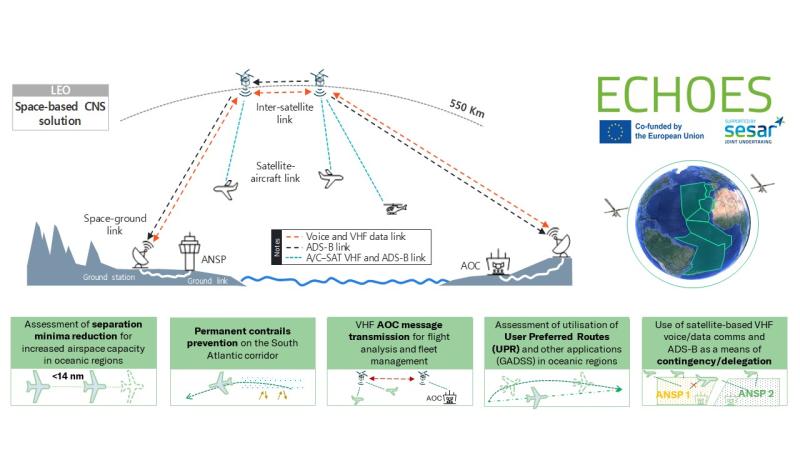In December 2023, the International Telecommunication Union World Radiocommunication Conference approved the spectrum allocation for future space-based VHF communications services (voice and data) and surveillance for air traffic management. This will allow SESAR to make significant strides forward to deliver satellite-based solutions for optimising air traffic control.
The conference authorised the allocation to AMS(R)S (aeronautical mobile-satellite (route) service) in the aeronautical VHF band (117.975 – 137 MHz), following several years of studies into the technical feasibility of the services from space, and their compatibility with existing services for both the same and the adjacent bands.
This historical event opens the way for innovation and significant improvements in air traffic control by allowing the use of satellites to provide aeronautical services in oceanic and remote areas.

In the context of Europe and SESAR, the now completed VOICE Project proved the feasibility of the ground segment as enabler of the space-based VHF communications in oceanic airspace and addressed the integration of the corresponding operational systems.
Building on the project, partners in the ECHOES Digital Sky Demonstrator, are now turning their attention to the space segment. Co-funded by the Connecting Europe Facility, the SESAR demonstrator aims to demonstrate the benefits of introducing direct-controller pilot-communication (DCPC) in oceanic airspace via VHF voice and data with the VHF ground stations being substituted by low earth orbit (LEO) satellites in combination with satellite-based automatic dependent surveillance–broadcast (ADS-B). All of this without any changes in existing aircraft avionics.
These space-based services have the possibility to provide air traffic management coverage to remote oceanic and continental areas and could serve in the future as backup for continental areas with ground station-based surveillance coverage. They could enable a reduction in aircraft separation, optimising routes and minimising CO2 emissions, while reinforcing the required level of operational safety.
ECHOES will confirm the technical feasibility of the services from space. The demonstration will be performed along the Atlantic corridor involving real traffic managed by ANSPs in Europe, Africa and South America. The demonstrator will work closely with regulatory and standardisation bodies in Europe and with ICAO to ensure interoperability with current avionics and to meet the required safety standards.

More about the Project
The demonstrator is lead by Startical, and brings together the following partners: Indra, ENAIRE, NAV Portugal, DLR, CRIDA, MITIGA.
Footer
- VOICE project has received EUR 3.989.808,75 funding from the SESAR Joint Undertaking under the European Union's Horizon 2020 research and innovation programme under Grant Agreement No 101017688.
- ECHOES project has received funding from the SESAR Joint Undertaking under the European Union’s Connecting Europe Facility programme under grant agreement No [101079448] under CINEA.
